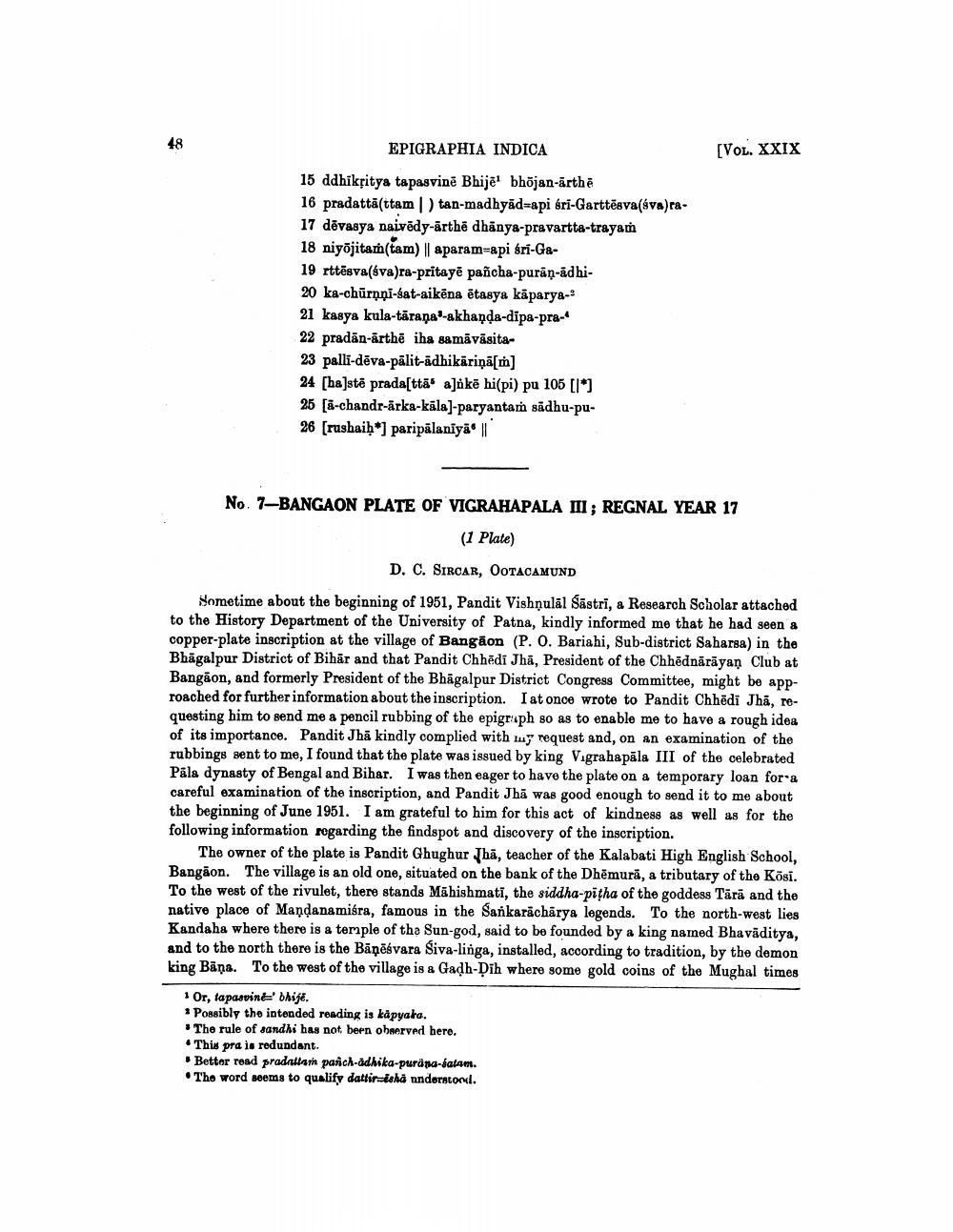________________
[VOL. XXIX
EPIGRAPHIA INDICA 15 ddhikțitys tapasvinē Bhijēl bhõjan-arthe 16 pradattā(ttam ) tan-madhyād=api sri-Garttēsva(sva)ra17 dēvasya naivēdy-arthë dhãnya-pravartta-trayam 18 niyojitam(tam) || aparam=api sri-Ga19 rttēsva(sva)ra-pritayē pañcha-puran-adhi20 ka-chūrņņi-sat-aikēna ētasya kaparya-- 21 kasya kula-tāraṇa'-akhaņda-dipa-pra22 pradān-arthē iha samāvāsita23 palli-dēva-palit-adhikariņā[m] 24 [ba]stē prada[ttā' a]ókē hi(pi) pu 105 [l*) 25 (ā-chandr-ārka-kāla)-paryantam sådhu-pu26 (rushaih*) paripālaniya ||
No. 7–BANGAON PLATE OF VIGRAHAPALA III ; REGNAL YEAR 17
(1 Plate)
D. C. SIRCAR, OOTACAMUND Sometime about the beginning of 1951, Pandit Vishộulal Šāstri, a Research Scholar attached to the History Department of the University of Patna, kindly informed me that he had seen & copper-plate inscription at the village of Bangāon (P. O. Bariahi, Sub-district Saharsa) in the Bhagalpur District of Bihār and that Pandit Chhēdi Jha, President of the Chhēdnārāyan Club at Bangaon, and formerly President of the Bhāgalpur District Congress Committee, might be approached for further information about the inscription. I at once wrote to Pandit Chhēdi Jhā, requesting him to send me a pencil rubbing of the epigraph so as to enable me to have a rough idea of its importance. Pandit Jhā kindly complied with my request and, on an examination of the rubbings sent to me, I found that the plate was issued by king Vigrahapāla III of the celebrated Pāla dynasty of Bengal and Bihar. I was then eager to have the plate on a temporary loan for a careful examination of the inscription, and Pandit Jhā was good enough to send it to me about the beginning of June 1951. I am grateful to him for this act of kindness as well as for the following information regarding the findspot and discovery of the inscription.
The owner of the plate is Pandit Ghughur Jha, teacher of the Kalabati High English School, Bangãon. The village is an old one, situated on the bank of the Dhēmură, a tributary of the Kösi. To the west of the rivulet, there stands Māhishmati, the siddha-pītha of the goddess Tārā and the native place of Mandanamiśra, famous in the Sankaracharya legends. To the north-west lies Kandaha where there is a temple of the Sun-god, said to be founded by a king named Bhavāditya, and to the north there is the Bāņēsvara Siva-linga, installed, according to tradition, by the demon king Bana. To the west of the village is a Gadh-Dih where some gold coins of the Mughal times
1 Or, tapasvint' bhije. * Possibly the intended reading is kapyala. • The rule of sandhi has not been obrerved here. • This pra is redundant.
Better read pradattath paich-adhika-purna-batam. • The word seems to qualify dattirishd understood.




